The Impact of Sanitary Felling During Large-Scale Disturbances on Regulating Ecosystem Services in Norway Spruce-Dominated Pre-Alpine Beech Forests of Slovenia
Abstract
1. Introduction
2. Materials and Methods
2.1. Study Area Description
2.2. Growing Stock and Sanitary Felling
2.3. Regulating Ecosystem Services
2.3.1. Soil Erosion Control
2.3.2. Regulation of Surface and Groundwater Flows
2.3.3. Regional Climate Regulation
2.3.4. Comparison of the Availability of Selected Regulating Ecosystem Services in Areas with and Without Sanitary Felling
3. Results
3.1. Growing Stock and Sanitary Felling
3.2. Regulating Ecosystem Services
3.2.1. Soil Erosion Control
3.2.2. Regulation of Surface and Groundwater Flows
3.2.3. Regional Climate Regulation
4. Discussion
5. Conclusions
Author Contributions
Funding
Data Availability Statement
Acknowledgments
Conflicts of Interest
References
- Spiecker, H. Silvicultural management in maintaining biodiversity and resistance of forests in Europe—Temperate zone. J. Environ. Manag. 2003, 67, 55–65. [Google Scholar] [CrossRef] [PubMed]
- Schütz, J.P. Silvicultural tools to develop irregular and diverse forest structures. For. Int. J. For. Res. 2002, 75, 329–337. [Google Scholar] [CrossRef]
- Lafond, V.; Lagarrigues, G.; Cordonnier, T.; Courbaud, B. Uneven-aged management options to promote forest resilience for climate change adaptation: Effects of group selection and harvesting intensity. Ann. For. Sci. 2014, 71, 173–186. [Google Scholar] [CrossRef]
- ForestEurope. State of Europe’s Forests 2020 Report; Ministerial Conference on the Protection of Forests in Europe; Liaison Unit Bratislava, ForestEurope: Zvolen, Slovak Republic, 2020. [Google Scholar]
- Senf, C.; Buras, A.; Zang, C.S.; Rammig, A.; Seidl, R. Excess forest mortality is consistently linked to drought across Europe. Nat. Commun. 2020, 11, 6200. [Google Scholar] [CrossRef]
- Patacca, M.; Lindner, M.; Lucas-Borja, M.E.; Cordonnier, T.; Fidej, G.; Gardiner, B.; Hauf, Y.; Jasinevičius, G.; Labonne, S.; Linkevičius, E.; et al. Significant increase in natural disturbance impacts on European forests since 1950. Glob. Change Biol. 2023, 29, 1359–1376. [Google Scholar] [CrossRef]
- Kutnar, L.; Kermavnar, J.; Pintar, A.M. Climate change and disturbances will shape future temperate forests in the transition zone between Central and SE Europe. Ann. For. Res. 2021, 64, 67–86. [Google Scholar] [CrossRef]
- Kermavnar, J.; Kutnar, L.; Pintar, A.M. Ecological factors affecting the recent Picea abies decline in Slovenia: The importance of bedrock type and forest naturalness. Iforest Biogeosciences For. 2023, 16, 105–115. [Google Scholar] [CrossRef]
- Spiecker, H. Growth of Norway spruce (Picea abies [L.] Karst.) under changing environmental conditions in Europe. In Proceedings of the Spruce Monocultures in Central Europe-Problems and Prospects; Klimo, E., Hager, H., Kulhavý, J., Eds.; EFI Proceedings No. 33. European Forest Institute: Joensuu, Finland, 2000; pp. 11–26. [Google Scholar]
- Hlásny, T.; Zimová, S.; Merganičová, K.; Štěpánek, P.; Modlinger, R.; Turčáni, M. Devastating outbreak of bark beetles in the Czech Republic: Drivers, impacts, and management implications. For. Ecol. Manag. 2021, 490, 119075. [Google Scholar] [CrossRef]
- Leuschner, C.; Ellenberg, H. Ecology of Central European Forests; Vegetation Ecology of Central Europe, Volume I; Springer International Publishing: Cham, Switzerland, 2017; p. 972. [Google Scholar] [CrossRef]
- Dakskobler, I. Pregled bukovih rastišč v Sloveniji. Zb. Gozdarstva Lesar. 2008, 87, 3–14. [Google Scholar]
- Dakskobler, I. Pregled bukovih rastišč v Sloveniji. In Bukovi Gozdovi v Sloveniji: Ekologija in Gospodarjenje; Bončina, A., Ed.; Oddelek za gozdarstvo in obnovljive gozdne vire, Biotehniška fakulteta: Ljubljana, Slovenia, 2012; pp. 59–74. [Google Scholar]
- Poljanec, A.; Ficko, A.; Klopčič, M.; Bončina, A. Razširjenost in razvojne spremembe bukovih gozdov v Sloveniji. In Bukovi Gozdovi v Sloveniji: Ekologija in Gospodarjenje; Bončina, A., Ed.; Oddelek za gozdarstvo in obnovljive gozdne vire, Biotehniška fakulteta: Ljubljana, Slovenia, 2012; pp. 45–57. [Google Scholar]
- Pintar, A.; Ferreira, A.; Krajnc, L.; Kušar, G.; Skudnik, M. Pestrost in pojavljanje domačih in tujerodnih drevesnih in grmovnih vrst na ploskvah Nacionalne gozdne inventure v Sloveniji. Acta Silvae Et Ligni 2024, 134, 11–26. [Google Scholar] [CrossRef]
- Seidl, R.; Spies, T.A.; Peterson, D.L.; Stephens, S.L.; Hicke, J.A. REVIEW: Searching for resilience: Addressing the impacts of changing disturbance regimes on forest ecosystem services. J. Appl. Ecol. 2016, 53, 120–129. [Google Scholar] [CrossRef]
- Thom, D.; Seidl, R. Natural disturbance impacts on ecosystem services and biodiversity in temperate and boreal forests. Biol. Rev. 2016, 91, 760–781. [Google Scholar] [CrossRef] [PubMed]
- Senf, C.; Seidl, R. Mapping the forest disturbance regimes of Europe. Nat. Sustain. 2021, 4, 63–70. [Google Scholar] [CrossRef]
- Lecina-Diaz, J.; Senf, C.; Grünig, M.; Seidl, R. Ecosystem services at risk from disturbance in Europe’s forests. Glob. Change Biol. 2024, 30, e17242. [Google Scholar] [CrossRef]
- Forzieri, G.; Dakos, V.; McDowell, N.G.; Ramdane, A.; Cescatti, A. Emerging signals of declining forest resilience under climate change. Nature 2022, 608, 534–539. [Google Scholar] [CrossRef]
- Pohjanmies, T.; Eyvindson, K.; Triviño, M.; Bengtsson, J.; Mönkkönen, M. Forest multifunctionality is not resilient to intensive forestry. Eur. J. For. Res. 2021, 140, 537–549. [Google Scholar] [CrossRef]
- Bosela, M.; Marcis, P.; Polťák, D.; Rybár, J.; Fleischer, P., Sr.; Fleischer, P., Jr.; Gömöryová, E.; Vido, J.; Nalevanková, P.; Škvarenina, J.; et al. Norway spruce monoculture has lower resilience and carbon sequestration capacity than a more diverse broadleaved forest: A case study in Central Europe. For. Ecol. Manag. 2025, 591, 122829. [Google Scholar] [CrossRef]
- Graser, A.; Georg, M.; Kallmayer, J.; Marten, A.; Pertl, C.; Rumpf, H.; Senf, C.; Kamp, J. Large-scale forest disturbance and associated management shape bird communities in Central European spruce forests. J. Appl. Ecol. 2025, 62, 329–343. [Google Scholar] [CrossRef]
- Hlásny, T.; Zimová, S.; Bentz, B. Scientific response to intensifying bark beetle outbreaks in Europe and North America. For. Ecol. Manag. 2021, 499, 119599. [Google Scholar] [CrossRef]
- Štraus, H.; Bončina, A. The vulnerability of four main tree species in European forests to seven natural disturbance agents: Lessons from Slovenia. Eur. J. For. Res. 2025, 144, 267–282. [Google Scholar] [CrossRef]
- Pavlin, J.; Nagel, T.A.; Svitok, M.; Pettit, J.L.; Begović, K.; Mikac, S.; Dikku, A.; Toromani, E.; Panayotov, M.; Zlatanov, T.; et al. Disturbance history is a key driver of tree life span in temperate primary forests. J. Veg. Sci. 2021, 32, e13069. [Google Scholar] [CrossRef]
- Seidl, R.; Thom, D.; Kautz, M.; Martin-Benito, D.; Peltoniemi, M.; Vacchiano, G.; Wild, J.; Ascoli, D.; Petr, M.; Honkaniemi, J.; et al. Forest disturbances under climate change. Nat. Clim. Change 2017, 7, 395–402. [Google Scholar] [CrossRef]
- Roženbergar, D.; Pavlin, J.; Nagel, T.A. Short-term survival and crown rebuilding of European broadleaf tree species following a severe ice storm. Can. J. For. Res. 2020, 50, 1131–1137. [Google Scholar] [CrossRef]
- Stare, D.; Ščap, Š.; Pezdevšek Malovrh, Š. Factors Influencing Private Forest Owners Decision-Making Rationalities to Implement Salvage Logging after Large-Scale Natural Disturbances in Slovenia. Croat. J. For. Eng. 2025, 46, 165–177. [Google Scholar] [CrossRef]
- Stare, D.; Uhan, Z.; Triplat, M.; Ščap, Š.; Krajnc, N.; Pezdevšek Malovrh, Š. Private Forest Owner Typology Based on Post-Disturbance Behaviour in Slovenia. Forests 2025, 16, 949. [Google Scholar] [CrossRef]
- Zawude Bakure, B.; Hundera, K.; Abara, M. Review on the effect of climate change on ecosystem services. IOP Conf. Ser. Earth Environ. Sci. 2022, 1016, 012055. [Google Scholar] [CrossRef]
- Dee, L.E.; Miller, S.J.; Helmstedt, K.J.; Boersma, K.S.; Polasky, S.; Reich, P.B. Quantifying disturbance effects on ecosystem services in a changing climate. Nat. Ecol. Evol. 2025, 9, 436–447. [Google Scholar] [CrossRef] [PubMed]
- Kovač, M.; Božič, G.; Ferreira, A.; Kušar, G.; Mali, B. A Five-Step Framework for Creating Forests for the Future. Forests 2024, 15, 912. [Google Scholar] [CrossRef]
- Locatelli, B. Ecosystem Services and Climate Change. In Routledge Handbook of Ecosystem Services, 1st ed.; Potschin, M., Haines-Young, R., Fish, R., Turner, R.K., Eds.; Routledge: London, UK, 2016. [Google Scholar]
- Reid, W.V.; Mooney, H.A.; Cropper, A.; Capistrano, D.; Carpenter, S.R.; Chopra, K.; Dasgupta, P.; Dietz, T.; Duraiappah, A.K.; Hassan, R.; et al. Ecosystems and Human Well-Being; Synthesis; Millennium Ecosystem Assessment; Island Press: Washington, DC, USA, 2005. [Google Scholar]
- European Union. EU Biodiversity Strategy for 2030. 2020. Available online: https://eur-lex.europa.eu/legal-content/EN/TXT/?uri=celex%3A52020DC0380 (accessed on 5 August 2025).
- European Union. New EU Forest Strategy for 2030. 2021. Available online: https://eur-lex.europa.eu/legal-content/EN/TXT/?uri=CELEX%3A52021DC0572 (accessed on 5 August 2025).
- Hessen, D.O.; Vandvik, V. Buffering Climate Change with Nature. Weather Clim. Soc. 2022, 14, 439–450. [Google Scholar] [CrossRef]
- Fleischer, P.; Pichler, V.; Fleischer, P., Jr.; Holko, L.; Máliš, F.; Gömöryová, E.; Cudlín, P.; Holeksa, J.; Michalová, Z.; Homolová, Z.; et al. Forest ecosystem services affected by natural disturbances, climate and land-use changes in the Tatra Mountains. Clim. Res. 2017, 73, 57–71. [Google Scholar] [CrossRef]
- Grima, N.; Edwards, D.; Edwards, F.; Petley, D.; Fisher, B. Landslides in the Andes: Forests can provide cost-effective landslide regulation services. Sci. Total Environ. 2020, 745, 141128. [Google Scholar] [CrossRef]
- Murgia, I.; Vitali, A.; Giadrossich, F.; Tonelli, E.; Baglioni, L.; Cohen, D.; Schwarz, M.; Urbinati, C. Effects of Land Cover Changes on Shallow Landslide Susceptibility Using SlideforMAP Software (Mt. Nerone, Italy). Land 2024, 13, 1575. [Google Scholar] [CrossRef]
- Vilhar, U.; Kermavnar, J.; Kozamernik, E.; Petrič, M.; Ravbar, N. The effects of large-scale forest disturbances on hydrology—An overview with special emphasis on karst aquifer systems. Earth-Sci. Rev. 2022, 235, 104243. [Google Scholar] [CrossRef]
- Richter, R.; Ballasus, H.; Engelmann, R.A.; Zielhofer, C.; Sanaei, A.; Wirth, C. Tree species matter for forest microclimate regulation during the drought year 2018: Disentangling environmental drivers and biotic drivers. Sci. Rep. 2022, 12, 17559. [Google Scholar] [CrossRef] [PubMed]
- Braziunas, K.H.; Rammer, W.; De Frenne, P.; Díaz-Calafat, J.; Hedwall, P.O.; Senf, C.; Thom, D.; Zellweger, F.; Seidl, R. Microclimate temperature effects propagate across scales in forest ecosystems. Landsc. Ecol. 2025, 40, 37. [Google Scholar] [CrossRef]
- Chen, S.; De Frenne, P.; Van Meerbeek, K.; Wu, Q.; Peng, Y.; Zheng, H.; Guo, K.; Yuan, C.; Xiong, L.; Zhao, Z.; et al. Macroclimate and canopy characteristics regulate forest understory microclimatic temperature offsets across China. Glob. Ecol. Biogeogr. 2024, 33, e13830. [Google Scholar] [CrossRef]
- ARSO. Arhiv Meritev-Opazovani in Merjeni Meteorološki Podatki po Sloveniji. 2025. Available online: http://meteo.arso.gov.si/met/sl/archive/ (accessed on 5 August 2025).
- ZGS. Gozdnogospodarski Načrt Gozdnogospodarske Enote Jelovica; Zavod za gozdove Slovenije, Območna enota Bled: Bled, Slovenia, 2022. [Google Scholar]
- Grad, K.; Ferjančič, L. Tolmač za list Kranj; L 33-65 Osnovna Geološka Karta 1:100000; Zvezni Geološki Zavod; Socialistična Federativna Republika Jugoslavija: Beograd, Serbia, 1976. [Google Scholar]
- Lisec, A.; Montanarella, L.; Vrščaj, B.; Kralj, T.; Lobnik, F.; Suhadolc, M.; Prus, T.; Mihelič, R.; Rupreht, J.; Zupan, M.; et al. Tla Slovenije: S Pedološko Karto v Merilu 1: 250 000; Skupno raziskovalno središče, Inštitut za okolje in trajnostni razvoj: Luxembourg City, Luxembourg; Ljubljana, Slovenia, 2015. [Google Scholar]
- BF. Pedološka Karta 1:250,00, ICPV BF; Univerza v Ljubljani: Ljubljana, Slovenia, 2015. [Google Scholar]
- Čarni, A.; Marinček, L.; Seliškar, A.; Zupančič, M.; Jogan, N.; Košir, P.; Zupanc, V.; Podobnik, A.; Vreš, B.; Šilc, U.; et al. Vegetacijska Karta Gozdnih Združb Slovenije: Merilo 1:400 000; ZRC SAZU, Biološki inštitut Jovana Hadžija: Ljubljana, Slovenia, 2002. [Google Scholar]
- Marinček, L.; Čarni, A. Komentar k Vegetacijski Karti Gozdnih Združb Slovenije v Merilu 1: 400.000; Biološki inštitut Jovana Hadžija, Založba ZRC SAZU: Ljubljana, Slovenia, 2002. [Google Scholar]
- Culiberg, M. Paleobotanični izsledki o navadni bukvi v Sloveniji. In Bukovi Gozdovi v Sloveniji: Ekologija in Gospodarjenje; Bončina, A., Ed.; Oddelek za gozdarstvo in obnovljive gozdne vire, Biotehniška Fakulteta: Ljubljana, Slovenia, 2012; pp. 45–57. [Google Scholar]
- ZGS. Gozdnogospodarski Načrt Gozdnogospodarske Enote Radovljica-Desni Breg Save; Zavod za gozdove Slovenije, Območna enota Bled: Bled, Slovenia, 2020. [Google Scholar]
- ZGS. Podatkovna Baza Timber 2018-2023; Zavod za gozdove Slovenije: Ljubljana, Slovenia, 2023. [Google Scholar]
- ZGS. Odseki; Zavod za gozdove Slovenije: Ljubljana, Slovenia, 2018. [Google Scholar]
- ZGS. Sestoji; Zavod za gozdove Slovenije: Ljubljana, Slovenia, 2010. [Google Scholar]
- ZGS. Sestoji; Zavod za gozdove Slovenije: Ljubljana, Slovenia, 2024. [Google Scholar]
- Haines-Young, R. Common International Classification of Ecosystem Services (CICES) V5.2 and Guidance on the Application of the Revised Structure; Fabis Consulting Ltd.: Nottingham, UK, 2023. [Google Scholar]
- Kobler, A. Uravnavanje erozije tal; Gozdarski inštitut Slovenije: Ljubljana, Slovenia, 2023. [Google Scholar]
- Renard, K.G.; Foster, G.R.; Weesies, G.A.; McCool, D.K.; Yoder, D.C. Predicting Soil Erosion by Water: A Guide to Conservation Planning with the Revised Universal Soil Loss Equation (RUSLE); USDA: Washington, DC, USA, 1997. [Google Scholar]
- Panagos, P.; Borrelli, P.; Poesen, J.; Ballabio, C.; Lugato, E.; Meusburger, K.; Montanarella, L.; Alewell, C. The new assessment of soil loss by water erosion in Europe. Environ. Sci. Policy 2015, 54, 438–447. [Google Scholar] [CrossRef]
- Frantar, P.; Herrmann, F.; Andjelov, M.; Draksler, A.; Wendland, F. Vodnobilančni model MGROWA-SI. In Proceedings of the 29. Mišičev Vodarski dan 2018, Maribor, Slovenia, 6 December 2018; pp. 199–205. [Google Scholar]
- Frantar, P.; Herrmann, F.; Andjelov, M.; Dolinar, M.; Bertalanič, R.; Gartner, D.; Sušnik, A.; Gregorič, G.; Petan, S.; Miklavčič, J.G.; et al. Water Balance Simulation Results for the Whole Country of Slovenia. 2018. Available online: https://meteo.arso.gov.si/uploads/probase/www/hidro/watercycle/text/sl/projects/mGROWA-SI/Prezentacija_mGROWA_201801a.pdf (accessed on 5 August 2025).
- Wang, C.; Liang, W.; Yan, J.; Jin, Z.; Zhang, W.; Li, X. Effects of vegetation restoration on local microclimate on the Loess Plateau. J. Geogr. Sci. 2022, 32, 291–316. [Google Scholar] [CrossRef]
- Hou, Y.; Wei, X. Forest Disturbance Thresholds and Cumulative Hydrological Impacts. Water Resour. Res. 2024, 60, e2024WR037339. [Google Scholar] [CrossRef]
- Forestry Commission. Managing Forests in Acid Sensitive Water Catchments; Forestry Commission: Edinburgh, Scotland, 2014. [Google Scholar]
- Stednick, J.D. Monitoring the effects of timber harvest on annual water yield. J. Hydrol. 1996, 176, 79–95. [Google Scholar] [CrossRef]
- Chivulescu, Ș.; Pitar, D.; Apostol, B.; Leca, Ș.; Badea, O. Importance of Dead Wood in Virgin Forest Ecosystem Functioning in Southern Carpathians. Forests 2022, 13, 409. [Google Scholar] [CrossRef]
- Keren, S.; Diaci, J. Comparing the Quantity and Structure of Deadwood in Selection Managed and Old-Growth Forests in South-East Europe. Forests 2018, 9, 76. [Google Scholar] [CrossRef]
- R Core Team. R: A Language and Environment for Statistical Computing; R Foundation Statistical Computing. Available online: http://www.R-project.org (accessed on 23 June 2025).
- Ščap, Š.; Klopčič, M.; Bončina, A. Naravna obnova gozdnih sestojev po vetrolomu na Jelovici. Gozdarski Vesntik 2013, 71, 195–212. [Google Scholar]
- Lackner, C.; Schreck, M.; Walli, A.M. Austrian Forest Report 2023; Federal Ministry of Agriculture, Forestry, Regions and Water Management: Vienna, Austria, 2023; p. 64. [Google Scholar]
- Skudnik, M.; Grah, A.; Guček, M.; Hladnik, D.; Jevšenak, J.; Kovač, M.; Kušar, G.; Mali, B.; Pintar, A.M.; Pisek, R.; et al. Stanje in Spremembe Slovenskih Gozdov Med Letoma 2000 in 2018: Rezultati Velikoprostorskega Monitoringa Gozdov in Gozdnih Ekosistemov; Gozdarski inštitut Slovenije, založba Silva Slovenica: Ljubljana, Slovenia, 2021; p. 88. [Google Scholar]
- Kušar, G.; Kovač, M. Ali se slovenski gozdovi odmikajo od trajnostnega razvoja? Acta Silvae Et Ligni 2024, 131, 1–27. [Google Scholar] [CrossRef]
- Pintar, A.M.; Skudnik, M. Identifying Even- and Uneven-Aged Forest Stands Using Low-Resolution Nationwide Lidar Data. Forests 2024, 15, 1407. [Google Scholar] [CrossRef]
- O’Hara, K.L.; Ramage, B.S. Silviculture in an uncertain world: Utilizing multi-aged management systems to integrate disturbance†. For. Int. J. For. Res. 2013, 86, 401–410. [Google Scholar] [CrossRef]
- Schütz, J.-P.; Saniga, M.; Diaci, J.; Vrška, T. Comparing close-to-nature silviculture with processes in pristine forests: Lessons from Central Europe. Ann. For. Sci. 2016, 73, 911–921. [Google Scholar] [CrossRef]
- Ilstedt, U.; Bargués Tobella, A.; Bazié, H.R.; Bayala, J.; Verbeeten, E.; Nyberg, G.; Sanou, J.; Benegas, L.; Murdiyarso, D.; Laudon, H.; et al. Intermediate tree cover can maximize groundwater recharge in the seasonally dry tropics. Sci. Rep. 2016, 6, 21930. [Google Scholar] [CrossRef]
- Jones, J.; Ellison, D.; Ferraz, S.; Lara, A.; Wei, X.; Zhang, Z. Forest restoration and hydrology. For. Ecol. Manag. 2022, 520, 120342. [Google Scholar] [CrossRef]
- Kašpar, V.; Hederová, L.; Macek, M.; Müllerová, J.; Prošek, J.; Surový, P.; Wild, J.; Kopecký, M. Temperature buffering in temperate forests: Comparing microclimate models based on ground measurements with active and passive remote sensing. Remote Sens. Environ. 2021, 263, 112522. [Google Scholar] [CrossRef]
- Sellin, A. Hydraulic and stomatal adjustment of Norway spruce trees to environmental stress. Tree Physiol. 2001, 21, 879–888. [Google Scholar] [CrossRef]
- Somers, L.D.; McKenzie, J.M. A review of groundwater in high mountain environments. WIREs Water 2020, 7, e1475. [Google Scholar] [CrossRef]
- Schmid, I.; Kazda, M. Root distribution of Norway spruce in monospecific and mixed stands on different soils. For. Ecol. Manag. 2002, 159, 37–47. [Google Scholar] [CrossRef]
- Gardiner, B.; Stacey, G.R. Designing forest edges to improve wind stability. For. Comm. Edinb. 1996, 75, 349. [Google Scholar]
- Gardiner, B.; Byrne, K.; Hale, S.; Kamimura, K.; Mitchell, S.J.; Peltola, H.; Ruel, J.-C. A review of mechanistic modelling of wind damage risk to forests. For. Int. J. For. Res. 2008, 81, 447–463. [Google Scholar] [CrossRef]
- Seidl, R.; Rammer, W. Climate change amplifies the interactions between wind and bark beetle disturbances in forest landscapes. Landsc. Ecol. 2017, 32, 1485–1498. [Google Scholar] [CrossRef] [PubMed]
- Gyssels, G.; Poesen, J.; Bochet, E.; Li, Y. Impact of plant roots on the resistance of soils to erosion by water: A review. Prog. Phys. Geogr. Earth Environ. 2005, 29, 189–217. [Google Scholar] [CrossRef]
- Sun, C.; Hou, H.; Chen, W. Effects of vegetation cover and slope on soil erosion in the Eastern Chinese Loess Plateau under different rainfall regimes. PeerJ 2021, 9, e11226. [Google Scholar] [CrossRef]
- Baker, W.L.; Hanson, C.T.; DellaSala, D.A. Harnessing Natural Disturbances: A Nature-Based Solution for Restoring and Adapting Dry Forests in the Western USA to Climate Change. Fire 2023, 6, 428. [Google Scholar] [CrossRef]
- Repo, A.; Albrich, K.; Jantunen, A.; Aalto, J.; Lehtonen, I.; Honkaniemi, J. Contrasting forest management strategies: Impacts on biodiversity and ecosystem services under changing climate and disturbance regimes. J. Environ. Manag. 2024, 371, 123124. [Google Scholar] [CrossRef]
- Schume, H.; Jost, G.; Hager, H. Soil water depletion and recharge patterns in mixed and pure forest stands of European beech and Norway spruce. J. Hydrol. 2004, 289, 258–274. [Google Scholar] [CrossRef]
- Magh, R.-K.; Eiferle, C.; Burzlaff, T.; Dannenmann, M.; Rennenberg, H.; Dubbert, M. Competition for water rather than facilitation in mixed beech-fir forests after drying-wetting cycle. J. Hydrol. 2020, 587, 124944. [Google Scholar] [CrossRef]
- Šípek, V.; Hnilica, J.; Vlček, L.; Hnilicová, S.; Tesař, M. Influence of vegetation type and soil properties on soil water dynamics in the Šumava Mountains (Southern Bohemia). J. Hydrol. 2020, 582, 124285. [Google Scholar] [CrossRef]
- Chiaradia, E.A.; Vergani, C.; Bischetti, G.B. Evaluation of the effects of three European forest types on slope stability by field and probabilistic analyses and their implications for forest management. For. Ecol. Manag. 2016, 370, 114–129. [Google Scholar] [CrossRef]
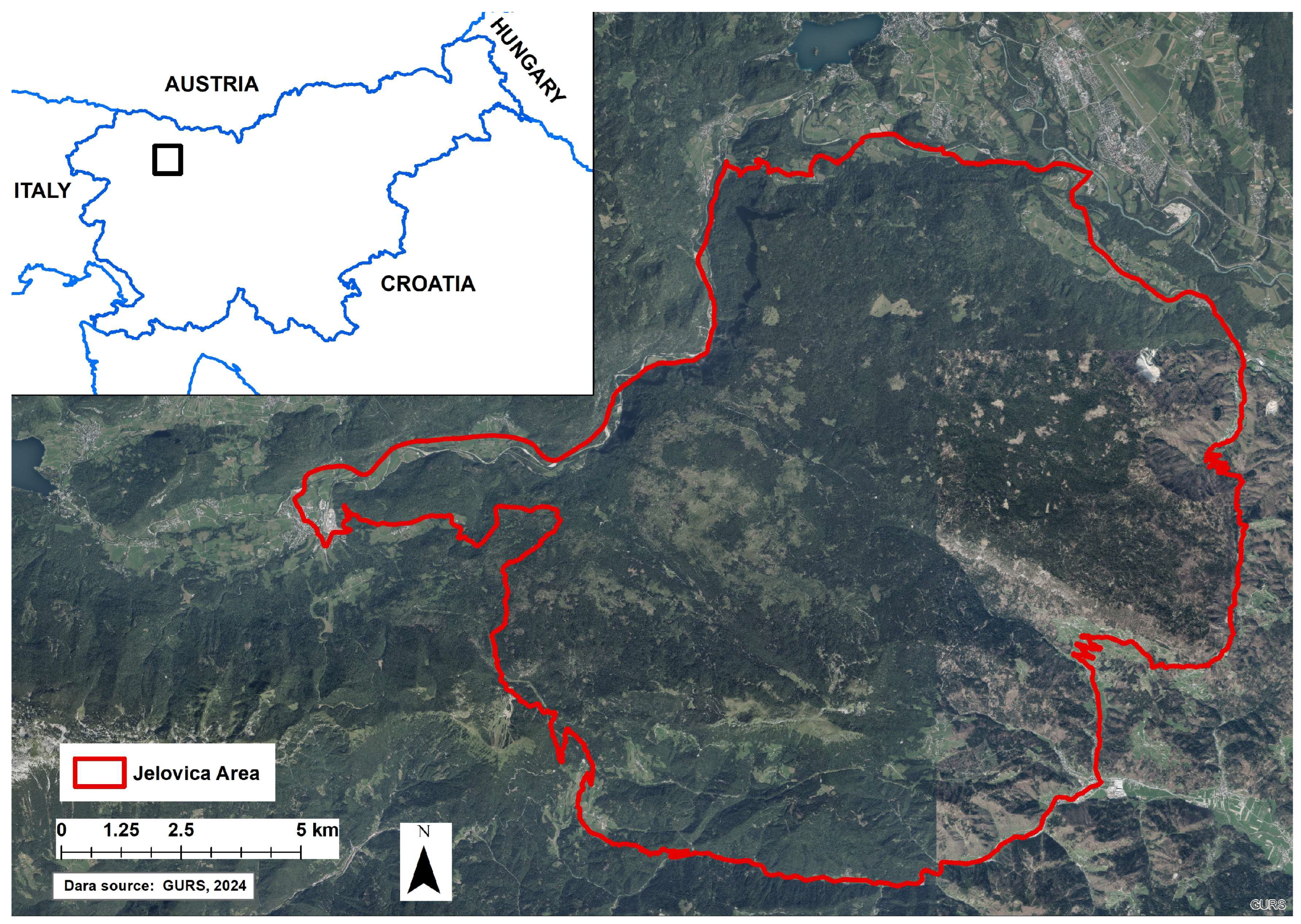
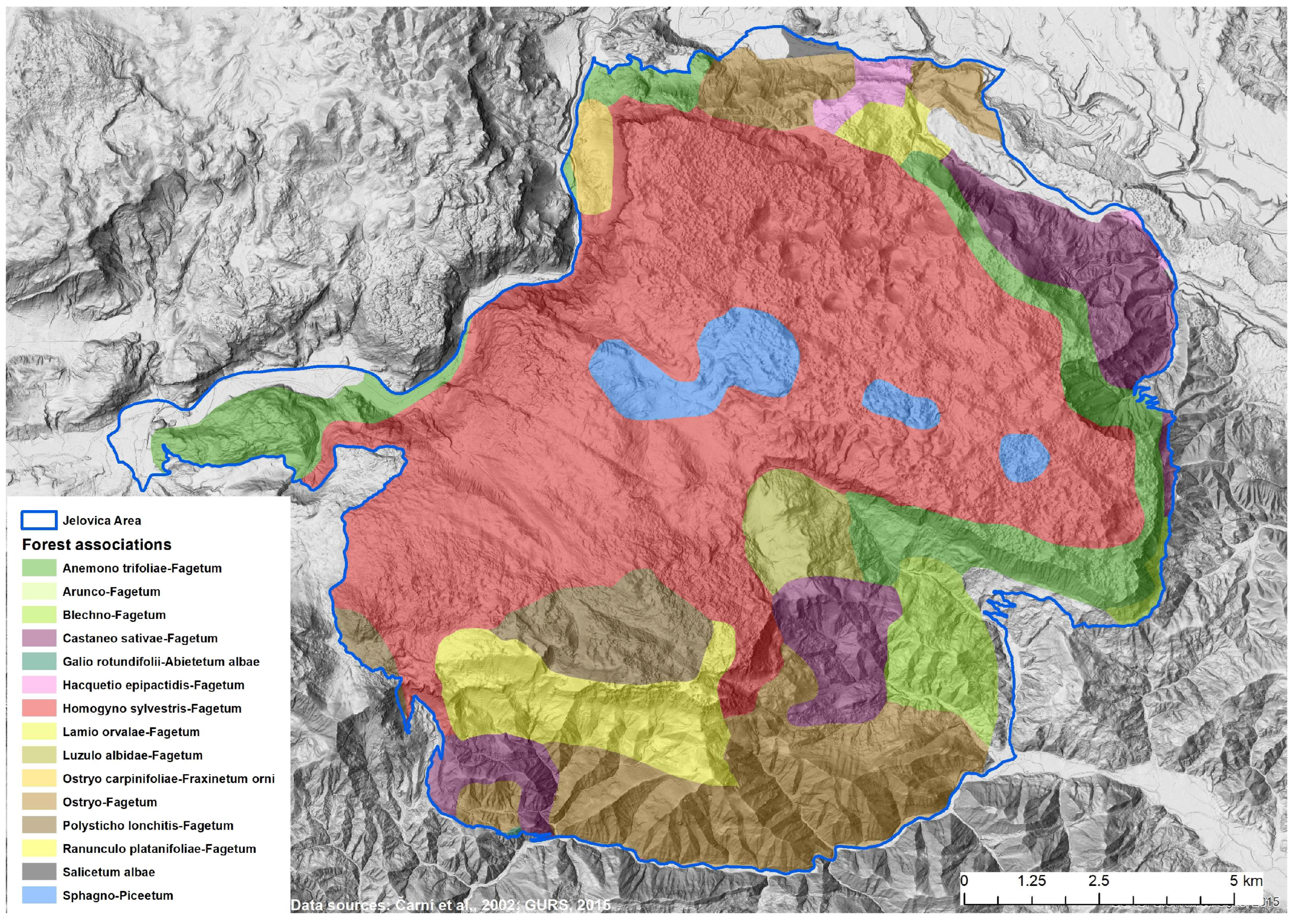
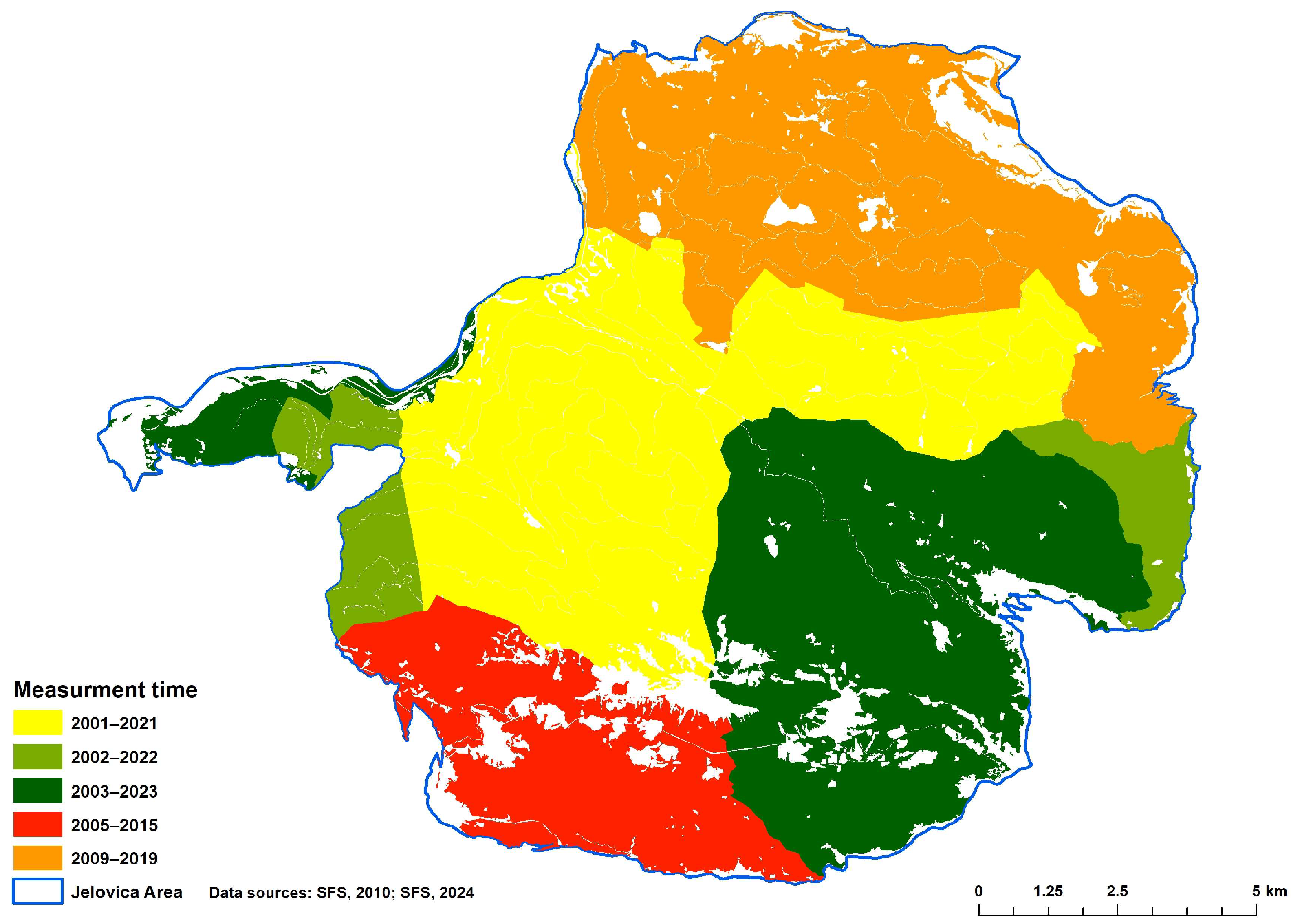

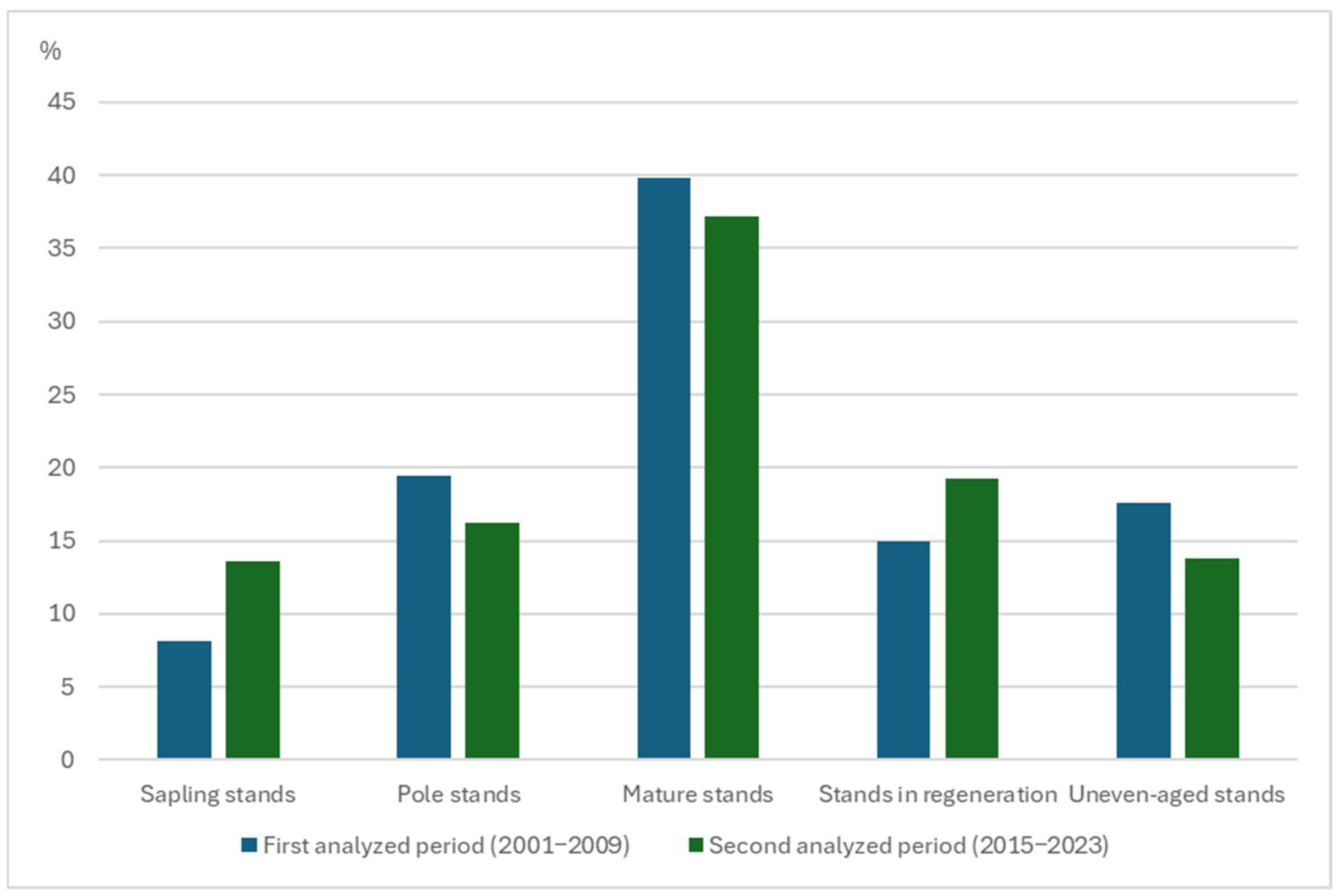
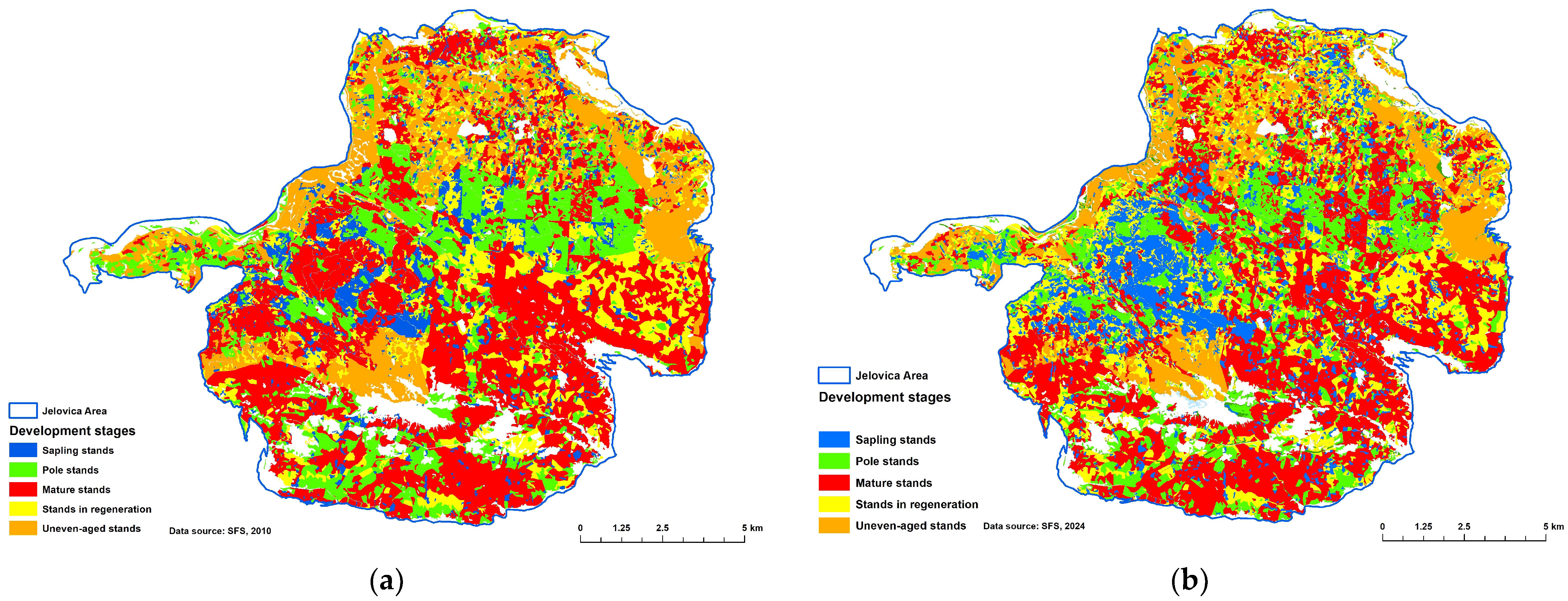
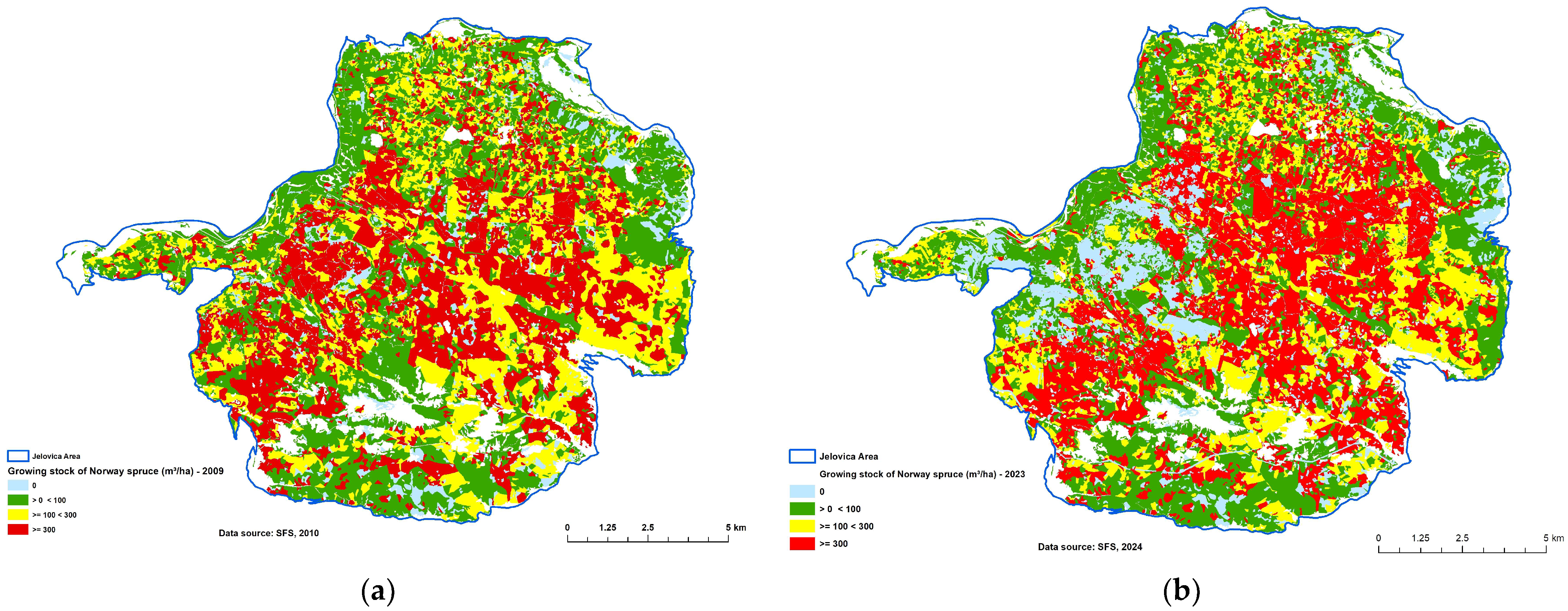

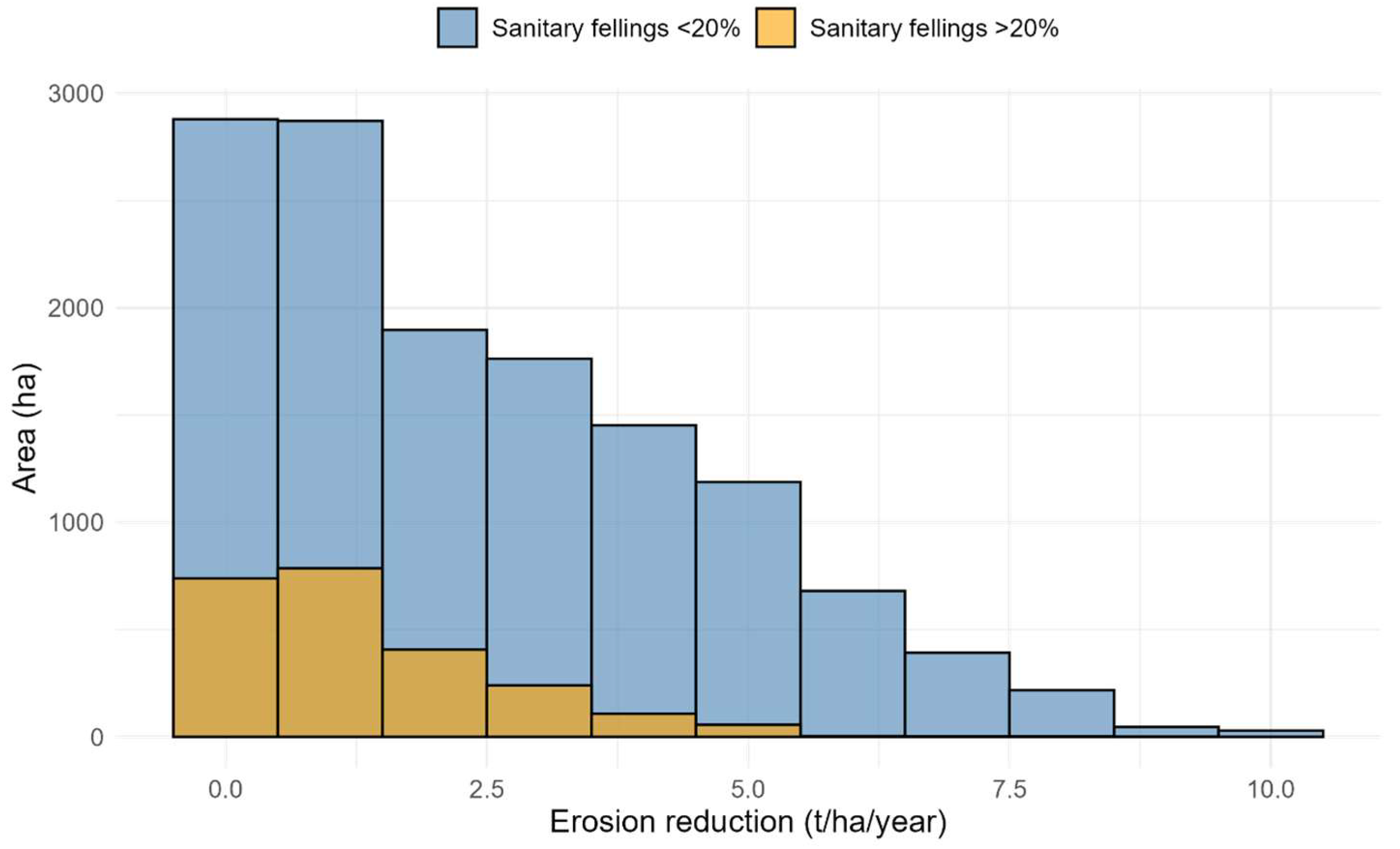
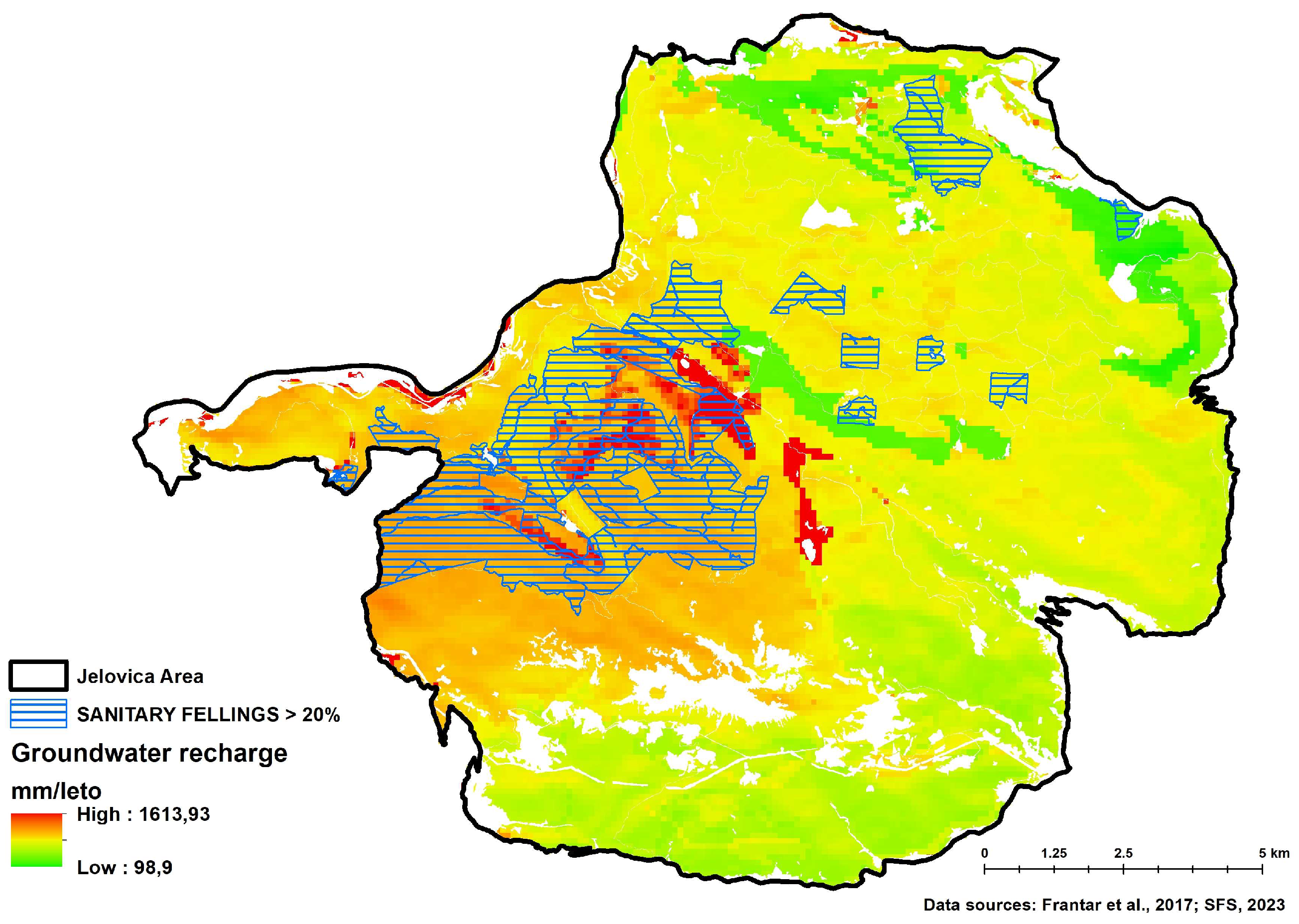
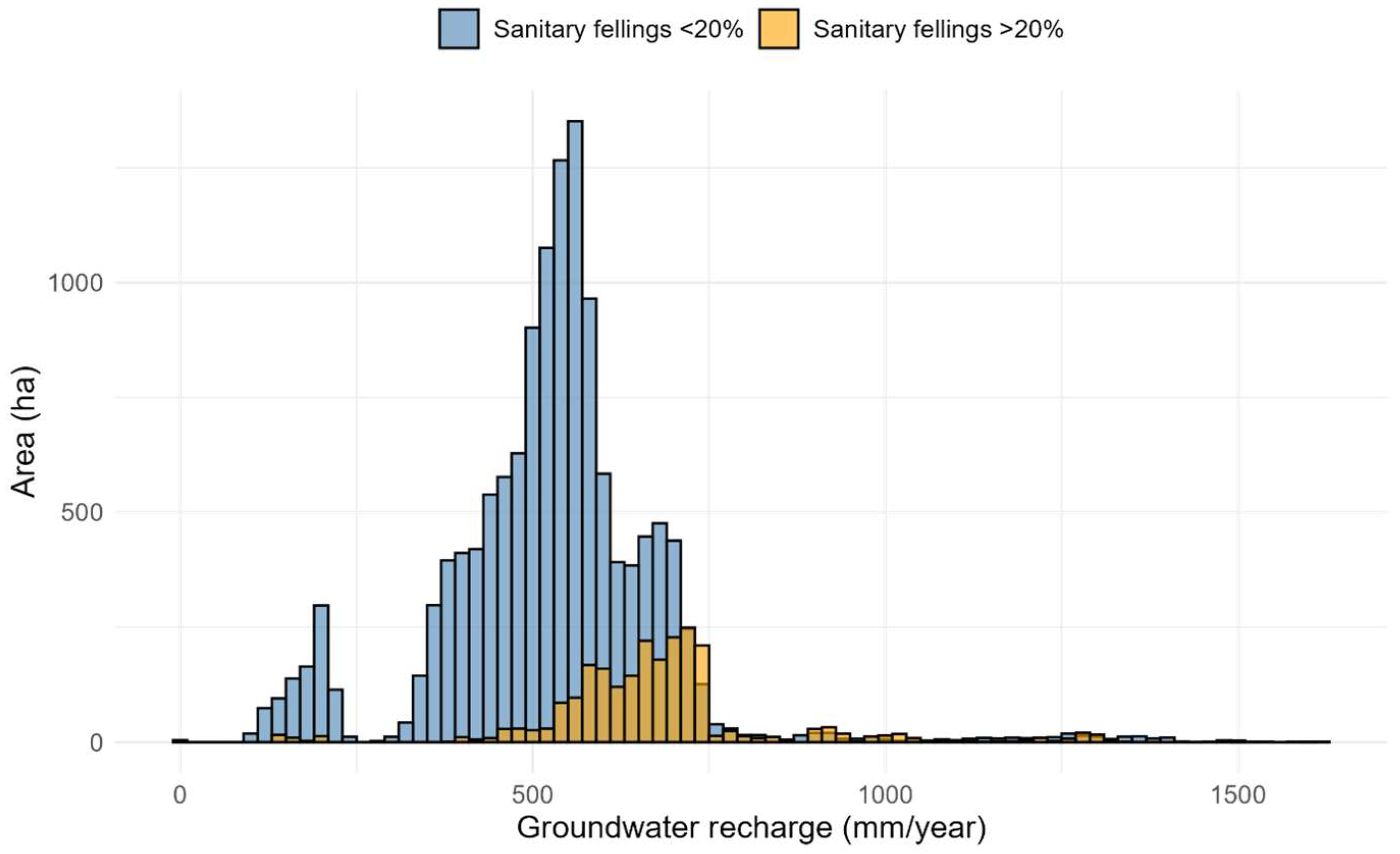
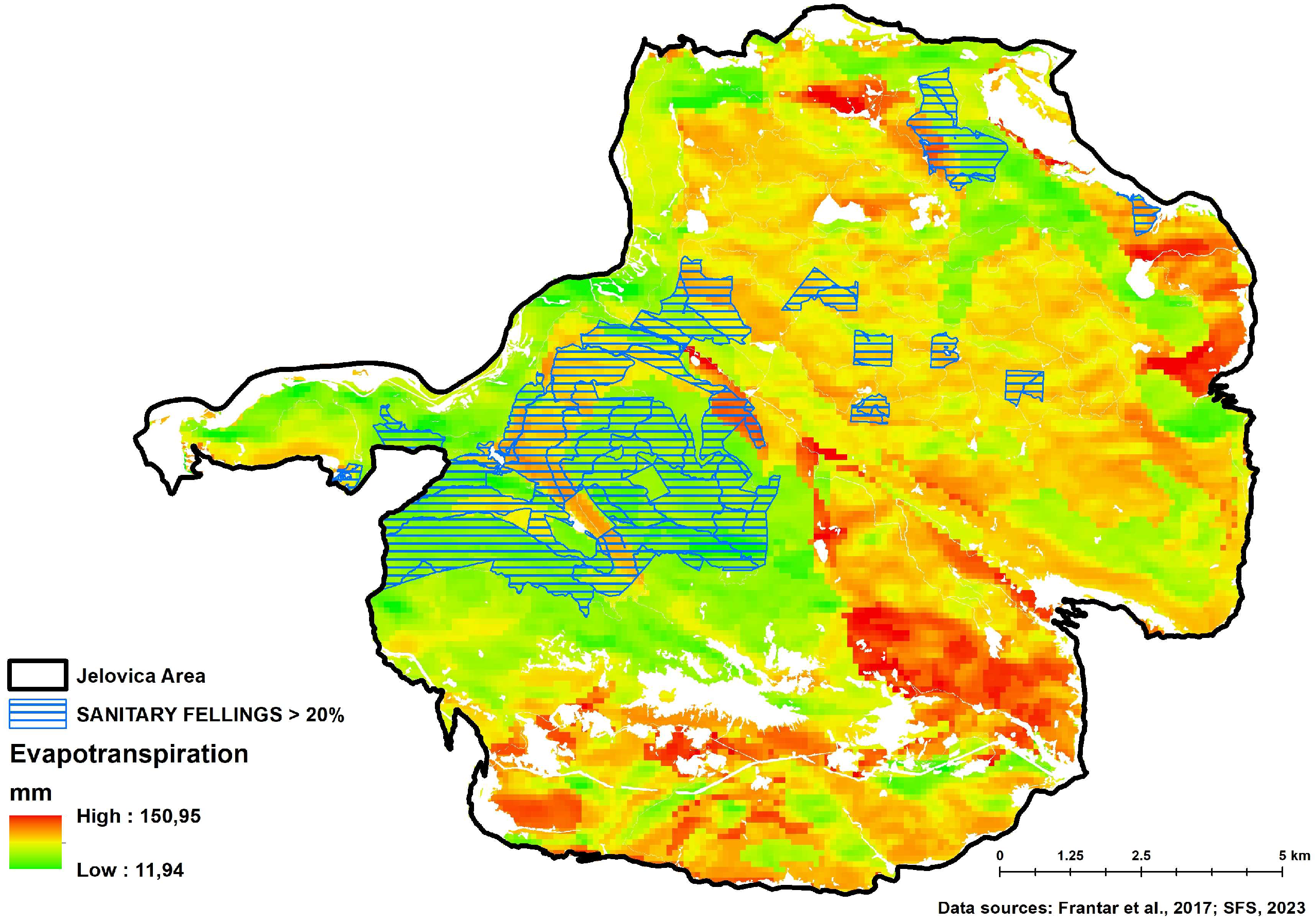
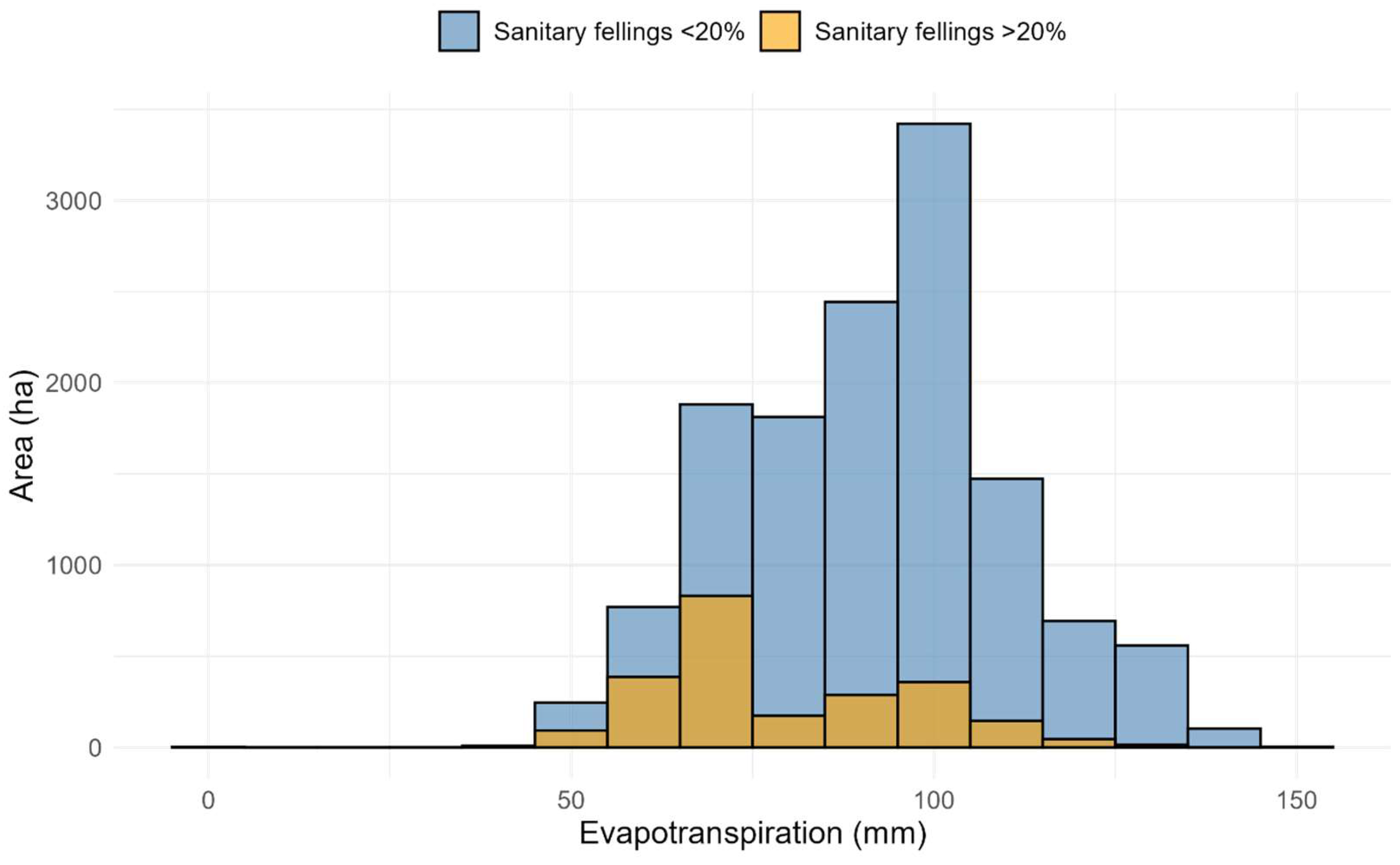
Disclaimer/Publisher’s Note: The statements, opinions and data contained in all publications are solely those of the individual author(s) and contributor(s) and not of MDPI and/or the editor(s). MDPI and/or the editor(s) disclaim responsibility for any injury to people or property resulting from any ideas, methods, instructions or products referred to in the content. |
© 2025 by the authors. Licensee MDPI, Basel, Switzerland. This article is an open access article distributed under the terms and conditions of the Creative Commons Attribution (CC BY) license (https://creativecommons.org/licenses/by/4.0/).
Share and Cite
Pintar, A.M.; Ferreira, A.; Höfferle, P.; Japelj, A. The Impact of Sanitary Felling During Large-Scale Disturbances on Regulating Ecosystem Services in Norway Spruce-Dominated Pre-Alpine Beech Forests of Slovenia. Forests 2025, 16, 1631. https://doi.org/10.3390/f16111631
Pintar AM, Ferreira A, Höfferle P, Japelj A. The Impact of Sanitary Felling During Large-Scale Disturbances on Regulating Ecosystem Services in Norway Spruce-Dominated Pre-Alpine Beech Forests of Slovenia. Forests. 2025; 16(11):1631. https://doi.org/10.3390/f16111631
Chicago/Turabian StylePintar, Anže Martin, Andreja Ferreira, Pia Höfferle, and Anže Japelj. 2025. "The Impact of Sanitary Felling During Large-Scale Disturbances on Regulating Ecosystem Services in Norway Spruce-Dominated Pre-Alpine Beech Forests of Slovenia" Forests 16, no. 11: 1631. https://doi.org/10.3390/f16111631
APA StylePintar, A. M., Ferreira, A., Höfferle, P., & Japelj, A. (2025). The Impact of Sanitary Felling During Large-Scale Disturbances on Regulating Ecosystem Services in Norway Spruce-Dominated Pre-Alpine Beech Forests of Slovenia. Forests, 16(11), 1631. https://doi.org/10.3390/f16111631






